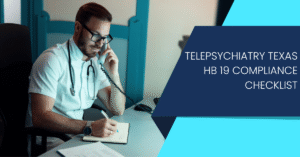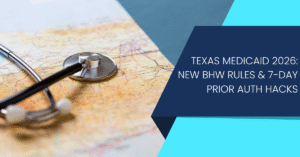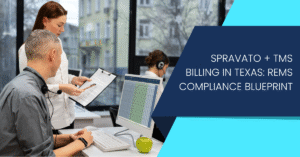Place of Service (POS) codes are vital to any medical billing process. The POS code is the location where a health professional performs the services, which significantly affects how claims are adjudicated and paid by payers. One of the most frequently used, yet widely misunderstood codes is POS 11.
POS 11 is integral to physician practices and simplifies the credentialing process, thus decreasing claim denials, enhancing their revenue cycle management (RCM). When you use this code correctly, it helps to prevent costly delays for non-compliance and ensure maximum reimbursements are received for services provided in the office.
1) What is POS 11?
POS 11 is defined as follows by the Centers for Medicare & Medicaid Services (CMS):
“Office – Location, other than a hospital’s or patients home; where a health professional provides medical or short-term therapy services (does not include the place where the provider simply scribbles on clipboard.)
Put another way, POS 11 is a doctor’s office — this is a fixed site owned, leased or rented by the physician or practice where patients go to receive care.
Example:
A cardiologist conducting visits in private clinics to see patients for check-ups, ECGs and through follow-up would apply POS 11 for those services.
2) When to Utilize POS-11 in Medical Billing
“Knowing when and how to use POS 11 is critical for compliance” and getting optimum remuneration:
Correct Scenarios:
- Follow-up Care Regular office visits
- Chronic condition management
- Subacute, noncatastrophic in-office procedures (era joint injections and wound care)
- Preventative Services like annual wellness visit
Avoid POS 11 If:
- Services are provided in the outpatient hospital setting (POS 22)
- The facility is hospital owned clinic.
- The care is provided with a facility that is not owned or operated by the physician.
Key Compliance Tip:
If the practice is hospital based, but still bills under POS 11, it should ensure that it complies with CMS requirements establishing that the facility is independent.
3) POS-11 Reimbursement Rules
There are many reasons why POS 11 is important, but one of them is payment variance:
Higher Reimbursement:
Services provided in the office and billed with POS 11 are generally reimbursed at higher rates than when performed in an outpatient hospital (POS 22). That’s because hospitals collect a “facility fee,” while office companies only get the physician fee.
Payer-Specific Variations:
Some health insurance companies may have exceptions to their POS requirement or payment reduction. Be sure to check payer policies so you’re not underpaid or denied.
4) POS-11 of POS-22 – Office vs Outpatient Hospital
|
Feature |
POS 11 – Office |
POS 22 – Outpatient Hospital |
|
Location |
Private physician office | Hospital outpatient clinic |
|
Ownership |
Physician or group-owned | Hospital-owned or operated |
| Reimbursement | Higher physician fee schedule |
Lower physician payment + facility fee |
| Common Use Case | Primary care visits, minor procedures |
Complex imaging, hospital-based care |
Impact on RCM:
Billing POS 22 when POS 11 is more appropriate can result in underpayments and beware— potential payer audits and compliance exposure.
5) ICD 11 Coding Accuracy Tips
So you don’t face any denials and get smooth processing:
Match CPT/HCPCS Codes:
Verify the selected procedure codes are characteristic of an office location. Some procedures mandate particular modifiers when performed outside a facility.
Use Clear Documentation:
Clearly note patient encounters, including location specifics and physician ownership of the space.
Verify Before Submission:
Refer to the payer for any specific POS rules or pre-authorization requirements.
6) POS 11—Credentialing and Eligibility Verification
So exactly how much is your billing directly impacted by the effectiveness of credentialing:
Eligibility Checks:
Verify patient’s insurance and office visit benefits PRIOR to scheduling or rendering of services.
Credentialing Compliance:
Office-based services: Providers need to be appropriately credentialed with each payer. POS misuse can result in network mismatch rejections.
Best Practice:
Add eligibility verification tools to your RCM system to lower your claim rejection rate.
7) POS 11 with office based approach for RCM
Strategic RCM Approach Needed to Maximize Revenue Under POS 11
Automate Eligibility Verification:
Confirm benefits and prevent claim delays with real-time eligibility checks.
Monitor Payer Trends:
It’s up to your practice to remain in compliance by keeping your eyes and ears open for payer policy changes that apply to POS 11.
Credentialing Automation:
Leverage technology solutions to automate credentialing processes and minimize risk of human error.
8) POS-11 Office Billing Mistakes
Common revenue-impacting errors are the following:
Incorrect POS Selection:
POS 22 or other service codes for services provided within the office.
Eligibility Oversights:
Failure to verify patient coverage for office visits, resulting in denials.
Incomplete Documentation:
Absent ownership or location information payers need for office claims.
9) Point of Sale 11 Best Practices
Staff Training:
Educate your front-desk and billing staff about POS 11 coding guidelines.
Cross-Check Payer Rules:
Stay current with CMS and commercial payer updates for any changes.
Internal Audits:
Periodic audits can be conducted to find billing mistakes and plug revenue leaks.
Leverage Technology:
Leverage RCM solutions with automation for credentialing, eligibility and coding validation.
Conclusion
POS 11 is not just a place code – it’s one of the critical tools for maximizing reimbursement and insurance claim accuracy for office-based providers. Practices that maintain up-to-date credentialing, verify eligibility in the front end and make sure CPT codes match closely can reduce denials and expedite payments.
Turn it into an advantage POS 11 helps physician offices submit clean claims, speed payments and maintain control of their financial health. Visit The Medicators for more effective Medical Billing Services across the USA.
FAQs
What is POS-11 on A CMS-1500 claim form, and when is it used?
POS 11 is defined as “Office” and is to be used for services provided within the office of a physician or other provider member that owns or operates his practice.
How does POS-11 reimbursement stand in comparison to POS 22?
(Usually POS 11 will pay more than 22 because outpatient hospitals are charged a facility fee, which takes dollars off of the physician’s payment.)
What are the top POS-11 CPT coding tips to ensure your billing is correct?
Match CPT/HCPCS with office based services, documentation ownership (p3), and check payer POS rules prior to claims submission.
What is the impact to POS-11 office billing claims with eligibility checking?
Instant eligibility validates claims to protect against rejections and verifies patients have coverage for office visits.
Which physician office-based RCM activities mitigate denials for POS 11?
Automate eligibility checking, track payer policy changes, perform audits and utilize RCM software for accuracy in coding.









